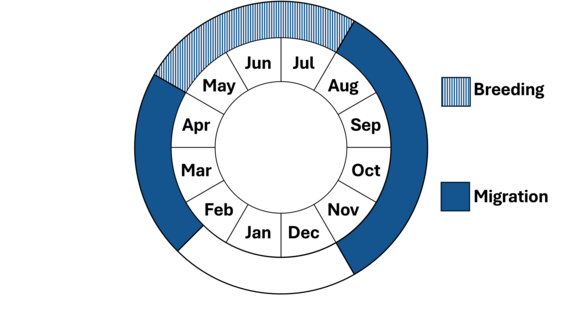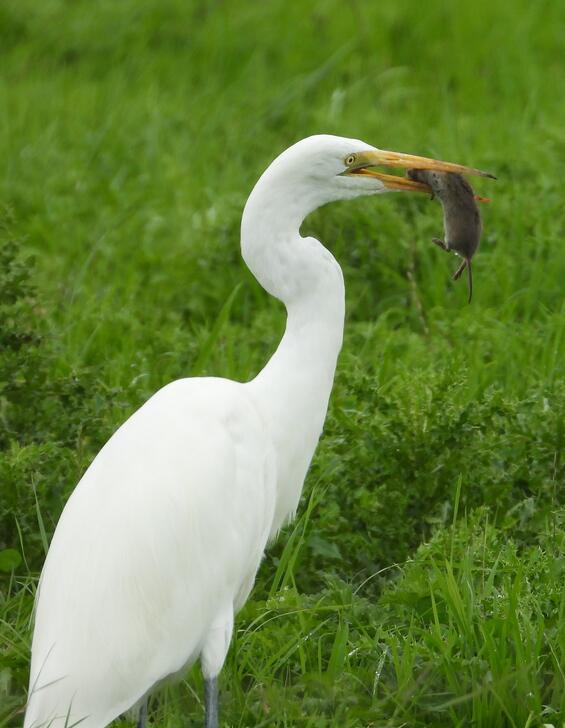- Scientific name: Ardea alba
- Species of Greatest Conservation Need (MA State Wildlife Action Plan)
Description
The largest North American egret, the great egret has a pure white plumage, black legs and feet, a long s-curved neck, and a large, yellow bill. When flying, the neck is tucked inward, and the legs stretch beyond the end of the tail. The great egret weighs about 1,000 g (35 oz) and has a wingspan of 131-145 cm (51-57 in).

Great egret (Ardea alba)
Life cycle and behavior
The great egret is a migratory bird that winters as far as South America. They arrive in Massachusetts in numbers in April, and nesting is well underway by mid-May, where they breed within coastal wading bird rookeries (e.g., herons, egrets, ibis). They build a stick nest towards the top of trees or shrubs with both male and female contributing to nest construction. They are single-brooded (laying an average of 3 eggs, range 1-6) but may renest following a nest failure. Both sexes participate in incubation, and eggs hatch approximately 25 days after incubation begins. Chicks stay at or near the nest until their first flight around 51 days after hatching. They gain independence approximately 2 weeks later. Fall migration for this species peaks in September and early October in Massachusetts.

Phenology in Massachusetts. This is a simplification of the annual life cycle. Timing exhibited by individuals in a population varies, so adjacent life stages generally overlap each other at their starts and ends.
Population status
In Massachusetts, great egret populations continue to increase in numbers and expand their range since periodic surveys began in the mid-1990s. Results of the number of documented nesting pairs from these surveys, with survey year in parentheses, are 69 (1994-1995), 228 (2006-2008), 386 (2013), and 451 (2018). This is due to both an increasing number of nesting colonies and the size of individual colonies.
Distribution and abundance
Historically, great egrets were nearly extirpated from North America due to unregulated plume-hunting for women’s hats. Following protections in the early 1900s, the population has been able to recover. According to the North American Breeding Bird Survey Partners in Flight, there are 9.5 million breeding birds in North America today. Present-day great egret breeding range is predominantly in coastal areas of the southeastern United States, but they have been expanding north in recent decades.
Habitat
They can use a variety of different habitats for nesting including islands, lakes, freshwater wetlands, and marine-estuarine habitats. In Massachusetts they almost exclusively nest in breeding colonies on islands off the coast. They feed on fish and may be seen foraging in a broad variety of wetland types and even flooded fields.
Healthy habitats are vital for supporting native wildlife and plants. Explore habitats and learn about conservation and restoration in Massachusetts.

Great egret (Ardea alba)
Threats
Feeding at fish-rearing facilities increases exposure to illegal shooting, while use of agricultural fields and drainage ditches make them susceptible to pesticides and heavy metal contamination. Feeding in natural wetlands downstream of agricultural fields and sewage treatment plants may also expose egrets to a variety of toxins. They are vulnerable to ingesting plastics and fishing line entanglement. Nesting colonies are vulnerable to predation and human disturbance.
Conservation
Conservation actions are best directed to reduce threats of disturbance and predation at known colonies. Habitat management may be needed for nesting colony persistence at some sites.
References
McCrimmon Jr., D. A., J. C. Ogden, G. T. Bancroft, A. Martínez-Vilalta, A. Motis, G. M. Kirwan, and P. F. D. Boesman. Great egret (Ardea alba), version 1.0. In Birds of the World (S. M. Billerman, Editor). Cornell Lab of Ornithology, Ithaca, NY, USA. 2020.
Walsh, J., and W.R. Petersen. Massachusetts Breeding Bird Atlas 2. Massachusetts Audubon Society and Scott & Nix, Inc. 2013.
Contact
| Date published: | April 22, 2025 |
|---|